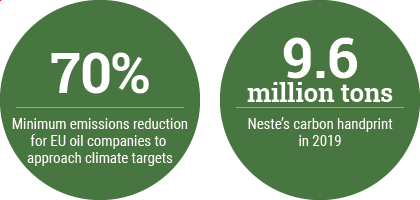
At first glance, the lubricants industry seems to be moving smoothly toward greater sustainability. But if you look more closely, you will notice obstacles that prevent companies from reaching their ambitious goals. In order to get sustainability efforts on track, the key lies in better understanding, tracking and marketing of their value. Neste’s approach to overcoming these hurdles boils down to three actionable steps.
Worldwide, capacity to generate renewable power and products, as well as biofuel production, are increasing substantially. This has been accomplished alongside impressive investments in efficiency improvements and research & development. While concerns over climate change have pushed forward decarbonization efforts over the past decade, concrete actions are now being taken by industry leaders.
Inspiring examples are everywhere. Shell aims for a 30% cut in the carbon intensity, or greenhouse gas emissions per energy unit, of its products by 2035 and a 65% cut by 2050. Companies like Repsol, Total, BP and Preem have announced targets of net zero emissions by 2050 or earlier. The strategies already show concrete actions like the announcement that Total will revamp a whole refinery from fossil to renewable feed. Outside of our industry, Microsoft’s ambitious plans have an end goal of the company becoming carbon negative in 2030.
For businesses, combating climate change has become economically smart, and they are taking visible steps without the pressure of laws and regulations influencing strategic decisions, sometimes even at the expense of short-term profitability. One such example is Neste’s renewable products business, which started up 14 years ago. It took some years to become profitable but has in recent years even outperformed the original oil products business within the company.
But companies must also be aware of the importance of not only being active in the area of sustainable development but also of communicating transparently about organizational efforts and results. Norway’s largest private asset management company, Storebrand, which manages a $91 billion fund, withdrew financing for several oil businesses, pointing to “climate lobbying activities that are not aligned with a sustainable development path” as the basis for its decision.
While the lubricants industry’s efforts are certainly noteworthy, concerns remain about the limited scale and projected outcome in the coming years or even decades. According to the International Energy Agency, oil and gas companies invest less than 1% of their total capital spend outside their core business areas. The agency asserts that “a much more significant change in overall capital allocation would be required to accelerate energy transitions.”
This is further backed by an analysis from the Transition Pathway Initiative, a global investor initiative supported by over $19 trillion in global capital. It concludes that the biggest oil and gas companies will not be able to reach a target of net zero emissions based on their current roadmaps. Reaching net zero worldwide emissions is necessary to limit a rise in global temperatures to 1.5–2 degrees Celsius above the pre-industrial level, as called for in the Paris Agreement.

According to a recent document published by TPI, European oil and gas companies would need to cut their emissions by over 70% between 2018 and 2050 to align with a 2˚C limit by the middle of the current century. Meanwhile, implementing a genuine net-zero strategy with a 100% cut in net emissions would be required to align with a 1.5˚C scenario within the same timeframe.
Concrete Efforts
So, what do the companies’ roadmaps to carbon neutrality usually mean in practice? For example, Neste has announced significant plans with more than 70 identified measures for reaching carbon-neutral production by 2035.
For the planet, reducing the carbon footprint is just as important as the carbon handprint—meaning the positive impact of our products and services provided to other actors in the value chain. Neste’s carbon handprint, or the size of the reduction of our customers’ carbon footprint attained by using our renewable products, amounted to 9.6 million tons of CO2 equivalent in 2019. The company is targeting 20 million tons annually by 2030.
Meanwhile, on the footprint side—the greenhouse gas emissions resulting from our own activities—many investments are needed that will allow us to safely reach our ambitious goals. Investments in energy efficiency and use of renewable electricity, like increasing the share of wind power in Finnish refineries to 30% as early as 2022, are just the start. Neste is also exploring further opportunities in implementing production methods with lower emissions and replacing fossil feedstock with recycled or renewable feed. One target is to process over one million tons of waste plastics annually by 2030.
Moreover, we have updated our investment criteria to make the greenhouse gas impact of all investments more transparent. We have also set an internal price for emissions in order to increase their weight in investment and business case evaluations.
Such actions aren’t just window dressing and can make significant impacts on the sustainability of an industry like lubricants. Base oils constitute a majority of the raw materials used by that industry, and since many base oil manufacturers receive process feed from parent refineries or companies, strategic choices higher up the supply chain can make a great impact.
Defining Common Standards
But obstacles to reaching industry-wide climate goals transcend investments and their insufficient scale. We also need to agree on standards to measure and report the impact of our present product systems. Until then, companies cannot accurately demonstrate the contribution that, for example, sustainable raw materials can make toward the sustainability of their own businesses.
Some reliable benchmarks exist, and should be examined to determine if they can be applied across the lubricants industry. For example, the Corporate Knights Methodology is based on a set of 21 key performance indicators covering diverse business aspects, from resource management to employee and financial management and supplier performance. This annual assessment surveys the sustainability of sizable companies based on publicly available data, revealing a holistic picture of their activities.
Measuring and reporting the impact of a whole product system from cradle to grave (or perhaps even from cradle to cradle) would summarize the results of our efforts clearly and concisely. Today, there are agreed-upon ways to measure the greenhouse gas impact in some areas or industries. But for lubricant production and use, there is not yet a specific system of rules and boundaries. Efforts are ongoing to develop such a system, including the work of the Union of the European Lubricants Industry (UEIL) Sustainability Taskforce last year, which has now become a standing committee. The European technical committee of petroleum additive manufacturers (ATC) is also examining how its members calculate their greenhouse gas emissions.
With such a foundation, the next step could be establishing an association representing the majority of the lubricants industry. With unified ways of measuring the carbon footprints of our products and activities, an organized body like the UEIL Sustainability Committee could be an even more meaningful voice for the industry.
This is crucial in better communicating the value of what we do and the needs of our industry. Currently, it is difficult to clearly and concisely explain how a high-quality lubricant can have a much bigger impact on the total greenhouse gas emissions of a vehicle through fuel savings relative to emissions from lubricant production. This can even be true when such lubricants are refined from crude oil, let alone the potential of high quality renewable solutions to accelerate the impact. Hence, the complete impact of a product system should be monitored and distilled to direct sustainable choices by corporations and consumers alike.
This approach would help communicate the benefits of new developments to stakeholders, partners and customers, showing the value of more sustainable alternatives compared to traditional solutions in the market. And this is essential, because our sustainability efforts are most effective with buy-in from all interested parties.
Three Steps, One Giant Leap
Believe it or not, our industry can enhance its sustainability profile by taking just three steps. We can improve and simplify the tracking, marketing and showcasing of our activities through the following:
- Collaborating and investing in reducing greenhouse gas emissions
- Reaching common standards for calculating the impact of our activities and products
- Speaking with a unified voice when communicating with both customers and legislative bodies
To paraphrase someone who had a unique perspective of our planet, I see them as just three small steps for our business, but a giant leap for our industry. So, shall we take the first one together?
Mika Kettunen, Ph.D., is technical product manager for base oils with Neste Corp. in Porvoo, Finland. Contact him at mika.kettunen@neste.com.